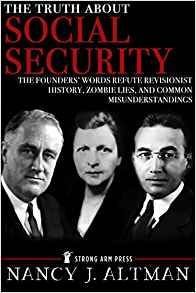Exploring Social Security’s history helps debunk current myths
Why Social Security is not unaffordable due to our aging population, driving up the debt or just a bunch of IOUs

No doubt you have heard some or all of the above claims from politicians and pundits debating solutions to the problems of our most important retirement program. The combined trust funds for the retirement and disability programs will be depleted in 2034, a problem that would require a draconian 23 percent across-the-board benefit cut if left unaddressed.
But Nancy Altman argues that these claims are not just wrong, but part of a purposeful campaign to undermine and dismantle Social Security that has been underway since its creation in the 1930s. Altman makes her case in a provocative, highly informative new book, The Truth About Social Security: The Founders’ Words Refute Revisionist History, Zombie Lies, and Common Misunderstandings (Strong Arm Press, August 2018).
Altman is a well-known progressive advocate for defending and expanding Social Security. But she also is an expert on the program and its history. She served as a staff member of the bipartisan 1983 commission that developed the last set of important reforms to Social Security, and serves on the board of the Social Security Advisory Board, an independent, bipartisan agency that advises the White House, Congress and Social Security Administration.
Her new book debunks a number of prevalent myths about Social Security, relying on the historical record left by President Franklin Roosevelt and the other founders of the program. In an interview, I asked Altman to discuss some of the key myths that she debunks using the historical record.
How to Blend Work and Retirement
Working longer can be a great way to boost your retirement security, or just stay engaged. But working longer doesn't necessarily require keeping your nose to the grindstone full-time--or even sticking with the same grindstone.
Leaving behind full-time work and the associated employee benefits becomes easier at age 65, when you qualify for Medicare. And that's what many older Americans say they aim to do. A recent report by the Transamerica Center for Retirement Studies found that 64% of workers of all ages envision a phased retirement involving continued work with reduced hours.
But how exactly to pull that off? Few employers have established structures for phased retirement.
Most often it's up to older workers to beat a new pathway to a blend of work and retirement, says Kerry Hannon, a writer and speaker who is an expert on careers and entrepreneurship.
Learn more in my column this week at Morningstar.com.
Tweet of the week

Just out from @CMSGov: lower average #Medicare #PartD premiums projected for 2019. One likely factor in lower bids: the manufacturer coverage gap discount will rise from 50% to 70% next year while plan costs in the gap shrink to 5%, courtesy of the BBA pic.twitter.com/aezSvmr9hA
July 31, 2018

